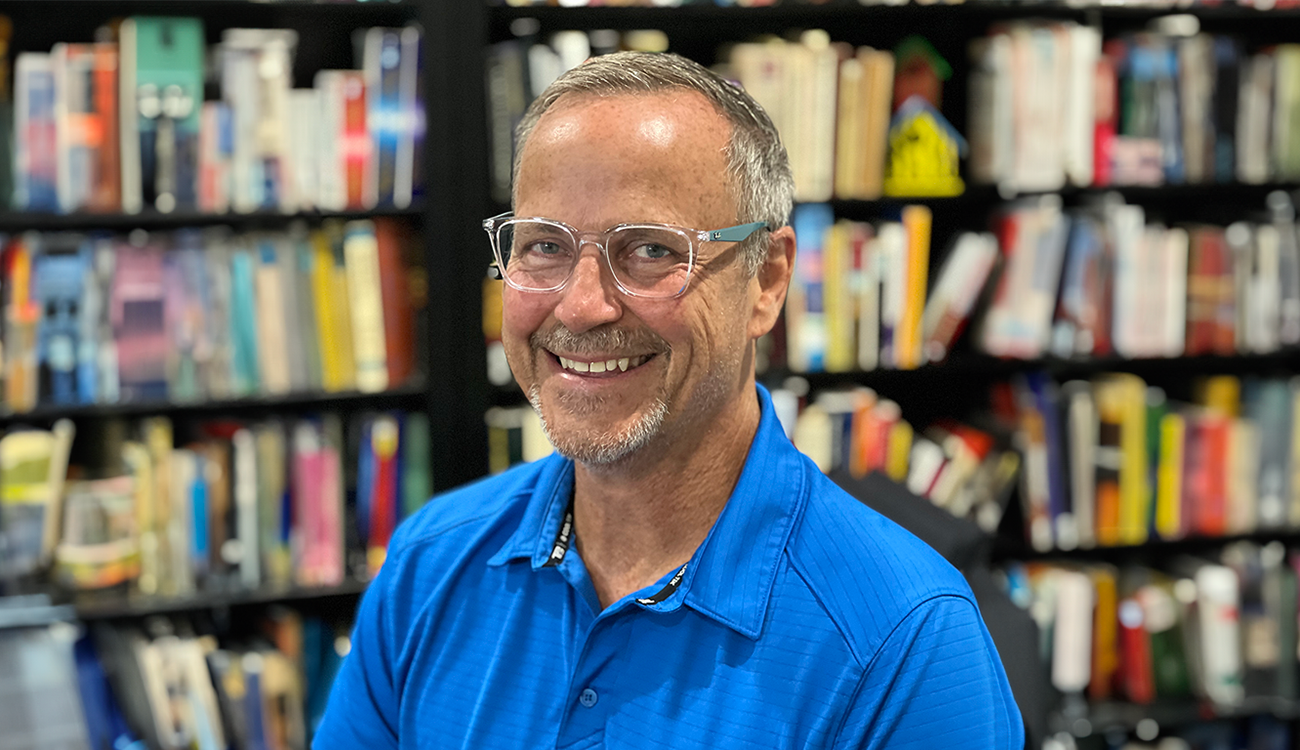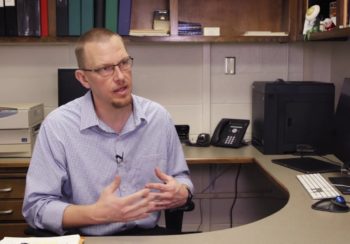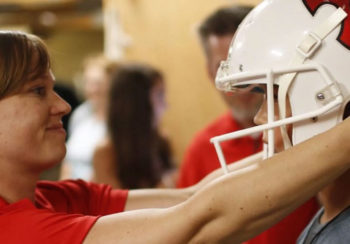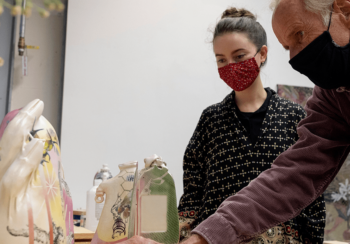University of Georgia Associate Professor John Gibbs always wanted to be involved in artificial intelligence. As far back as the late 1970s and early 1980s, when he was preparing to enter college, he was fascinated by how neural networks modeling the human brain might revolutionize technology and bring it closer to the worlds depicted in Hollywood or science fiction novels.
There was one problem.
“I was born about five years too early,” he said.
When Gibbs applied for colleges, there simply weren’t many computer science programs immersed in AI research. The Massachusetts Institute of Technology was one option, but it was the one program he wasn’t accepted to.
For the time being, Gibbs was forced to go in a different direction. He went to Princeton University to study physics, then earned master’s and doctoral degrees from the Ohio State University in English language and literature.
Then began a long hiatus from his curiosity about AI, during which he built different skills in arts and animation—until 2015, when he was finally able to scratch that 30-year-old itch. With his kids a little older and having more time to devote, he began studying for a master’s in AI at UGA.
Now, combining the various interests in AI and the arts that he has mastered over the course of his studies, Gibbs and his students are exploring solutions for digital animation—and considering philosophically the repercussions these new creative and assistive technologies could bring about.
The promise of AI in creativity
Gibbs first came to UGA in 2006 as a professor in the Franklin College of Arts & Sciences Department of Theatre and Film Studies, where he taught graduate and undergraduate courses in 3D animation, motion capture, screen and stage writing, and modern drama, among other things.
It’s not exactly the area of expertise one might immediately associate with artificial intelligence (at least not at the time). His Ph.D. dissertation—“No-thing is more real than nothing: Zen/Chaos Theory in the Dramatic Art of Samuel Beckett”—offered no glimpse of this future work. Nor did his minor in music composition and theory at Princeton in 1987.
If anything, though, Gibbs has personified a shift in the way we view AI and culture today: It is everywhere.
“It was probably the summer of 2022 or so, and I did a video on my YouTube channel,” Gibbs said, referring to his alternate online personality, “Dr. Know-It-All,” which has just over 70,000 subscribers and garners thousands of views for each new video. “I made a prediction that the golden age of AI was over, and it would take another 5-10 years to catch back up.
“I was way off.”
Instead of hitting a wall, AI has exploded into the mainstream over the course of the past year. Areas of expertise that may have been historically unrelated have serendipitously merged for Gibbs. Large-language models like ChatGPT can help writers, whether in music, novels, screenwriting and something else entirely. DALL-E and Midjourney can help graphic designers develop new imagery or graphics.
Gibbs’ own product, which merges his skills in animation and machine learning, solves a very specific challenge for digital animators. His company is Artimatic, and he formed it with his former student, Ben Flanders. Together they developed a program called skiNNer, which assists in some of the most monotonous drudge work for an animator. The program recently received a $275,000 National Science Foundation/Small Business Innovation Research grant
It’s called weight painting. When you have a humanoid character (or any other live animal, like a dog or a dragon), an animator will create a 3D model. You might laser scan a person and design based on image capture, but what you are left with is essentially a clay model of the character.
“There’s something there but nothing inside it to make it move,” said Gibbs, also a Faculty Fellow in the Institute for Artificial Intelligence. “Unless you want to have it hop around like a chess piece, you have to put a skeleton inside of it.”
And then comes the drudge work. Every movement must be carefully programmed: An arm motion in this direction causes a pull on this bone or a crease in this joint. A bent head to the right tugs the left shoulder just so.
“There are algorithms that get it 80% of the way there,” Gibbs said. “But it’s that last 20% that is a huge pain. And it can take a couple of days to do a good job.”
Now, skiNNer can do that heavy lifting. Using machine learning, it can take out the hours of trial and error that cause so much stress in the lives of 3D animators. In place of that time, they are freed to work on fun creations or explore new designs.
It’s one of many similar projects Gibbs and colleagues pursue in this domain, leveraging technology to assist in the creation of art.
“That’s the promise,” Gibbs said of his work in this space, noting he had surveyed animators to see whether they would feel threatened by such a program. “That’s the good side.”
A top-down revolution
In a perfect world, this is the place for artificial intelligence in the arts. skiNNer and programs like it can take on the repetitive tasks, freeing humans to create more and expand the boundaries of art, whether writing a short novel or building animations for smash-hit Hollywood feature films.
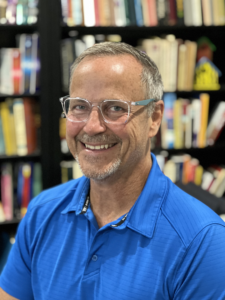
But Gibbs also recognizes the challenges. And the challenges are many.
“It’s a revolution happening from the top down,” he said. “Classically, if you think of the Industrial Revolution, it started from the bottom with wool weavers and plows and things. It was alleviating the manual labor and freeing people to pursue other vocations. Yes, jobs are always automated away, but largely you were creating new, better jobs for people to pursue.
“This is starting at the opposite end.”
The question Gibbs wrestles with is whether these short-term advantages in animation could become a wholesale takeover of the creative field down the road.
“Right now, these programs do fine,” he said. “But after a while they can get repetitive. If I have ChatGPT create a screenplay for me, for example, it can sort of do it, but it’s not really doing it to the level that a human can. But that can, maybe even likely will, change.”
And when it does, will the task of creation itself be outsourced to technology? It’s one reason recently striking writers and actors fought so hard with studios to gain new protections for their work. And despite the challenges, Gibbs still maintains a somewhat positive outlook.
“This has some very, very amazing benefits,” he stressed. “We could be looking at a world where we don’t really have to take part in these sorts of rigorous tasks, where we can be free to be creative and explore and learn.
“Everyone is just trying to keep up right now, and we’re not entirely sure what the future holds.”
For his part, Gibbs is excited.
Although he felt like he was born about five years too early, in reality he may have prepared himself to be uniquely positioned to have an impact within AI and the arts.
“It’s worked out,” he said. “I wanted to go straight into computer science out of high school, but maybe then I wouldn’t have been able to pursue all these other things I was interested in. Maybe it’s worked out where I’m right on time.”



